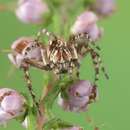en
names in breadcrumbs


Oxyopes is a genus of lynx spiders found worldwide. It includes arounds 300 species and is classified under the lynx spider family Oxyopidae.[1][2] Like other lynx spiders, they are easily recognizable by the six larger eyes arranged hexagonally on top of the head (prosoma), with the remaining smaller two eyes in front. They are also characterized by long spine-like bristles (setae) on their legs.[3] They are ambush predators, actively hunting prey by sight. Though they produce and use silk, they do not build webs to capture prey.[4]
The genus was first established in 1804 by the French zoologist Pierre André Latreille.[1] The generic name means "keen-eyed", from Ancient Greek ὀξύς (oxús, "sharp") and ὤψ (ṓps, "eye").[5]
Species classified under Oxyopes (including subspecies) and their distribution ranges are the following:[1]
Oxyopes is a genus of lynx spiders found worldwide. It includes arounds 300 species and is classified under the lynx spider family Oxyopidae. Like other lynx spiders, they are easily recognizable by the six larger eyes arranged hexagonally on top of the head (prosoma), with the remaining smaller two eyes in front. They are also characterized by long spine-like bristles (setae) on their legs. They are ambush predators, actively hunting prey by sight. Though they produce and use silk, they do not build webs to capture prey.
The genus was first established in 1804 by the French zoologist Pierre André Latreille. The generic name means "keen-eyed", from Ancient Greek ὀξύς (oxús, "sharp") and ὤψ (ṓps, "eye").